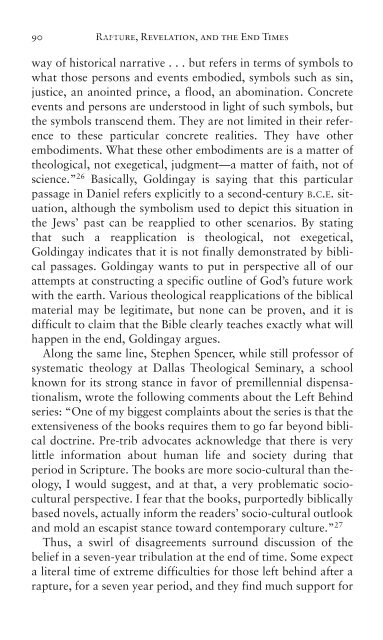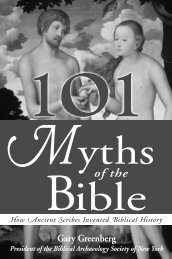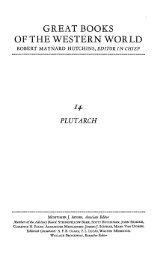Rapture, Revelation, and the End Times - Conscious Evolution TV
Rapture, Revelation, and the End Times - Conscious Evolution TV
Rapture, Revelation, and the End Times - Conscious Evolution TV
Create successful ePaper yourself
Turn your PDF publications into a flip-book with our unique Google optimized e-Paper software.
90robin-bobin <strong>Rapture</strong>, <strong>Revelation</strong>, <strong>and</strong> <strong>the</strong> <strong>End</strong> <strong>Times</strong>way of historical narrative . . . but refers in terms of symbols towhat those persons <strong>and</strong> events embodied, symbols such as sin,justice, an anointed prince, a flood, an abomination. Concreteevents <strong>and</strong> persons are understood in light of such symbols, but<strong>the</strong> symbols transcend <strong>the</strong>m. They are not limited in <strong>the</strong>ir referenceto <strong>the</strong>se particular concrete realities. They have o<strong>the</strong>rembodiments. What <strong>the</strong>se o<strong>the</strong>r embodiments are is a matter of<strong>the</strong>ological, not exegetical, judgment—a matter of faith, not ofscience.” 26 Basically, Goldingay is saying that this particularpassage in Daniel refers explicitly to a second-century B.C.E. situation,although <strong>the</strong> symbolism used to depict this situation in<strong>the</strong> Jews’ past can be reapplied to o<strong>the</strong>r scenarios. By statingthat such a reapplication is <strong>the</strong>ological, not exegetical,Goldingay indicates that it is not finally demonstrated by biblicalpassages. Goldingay wants to put in perspective all of ourattempts at constructing a specific outline of God’s future workwith <strong>the</strong> earth. Various <strong>the</strong>ological reapplications of <strong>the</strong> biblicalmaterial may be legitimate, but none can be proven, <strong>and</strong> it isdifficult to claim that <strong>the</strong> Bible clearly teaches exactly what willhappen in <strong>the</strong> end, Goldingay argues.Along <strong>the</strong> same line, Stephen Spencer, while still professor ofsystematic <strong>the</strong>ology at Dallas Theological Seminary, a schoolknown for its strong stance in favor of premillennial dispensationalism,wrote <strong>the</strong> following comments about <strong>the</strong> Left Behindseries: “One of my biggest complaints about <strong>the</strong> series is that <strong>the</strong>extensiveness of <strong>the</strong> books requires <strong>the</strong>m to go far beyond biblicaldoctrine. Pre-trib advocates acknowledge that <strong>the</strong>re is verylittle information about human life <strong>and</strong> society during thatperiod in Scripture. The books are more socio-cultural than <strong>the</strong>ology,I would suggest, <strong>and</strong> at that, a very problematic socioculturalperspective. I fear that <strong>the</strong> books, purportedly biblicallybased novels, actually inform <strong>the</strong> readers’ socio-cultural outlook<strong>and</strong> mold an escapist stance toward contemporary culture.” 27Thus, a swirl of disagreements surround discussion of <strong>the</strong>belief in a seven-year tribulation at <strong>the</strong> end of time. Some expecta literal time of extreme difficulties for those left behind after arapture, for a seven year period, <strong>and</strong> <strong>the</strong>y find much support forrobin-bobin





